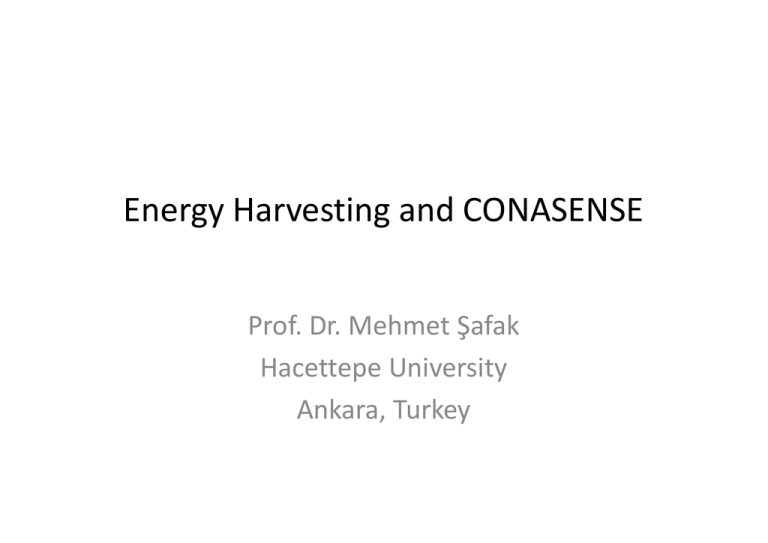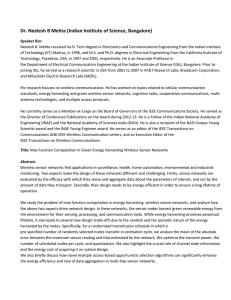Energy Harvesting and CONASENSE
advertisement

Energy Harvesting and CONASENSE Prof. Dr. Mehmet Şafak Hacettepe University Ankara, Turkey Outline • Energy in wireless nodes – Demand vs supply • Energy supply – Battery – Energy harvesting • Energy-efficient designs • Nanogenerators and nanopiezotronics – Operation in THz band • Conclusions WPMC 2012, 24-27 Sept. 2012 2 Energy Consumption • Energy consumption of wireless sensor/communication nodes is crucial in CONASENSE applications. – Life-time – Cost of maintainence and replacement – Difficulty/inconveniance of reaching densely populated nodes – Independent, sustainable and continuous operation WPMC 2012, 24-27 Sept. 2012 3 General Structure of a Wireless Node Demand Supply D. Niyato, E. Hossain, M.M. Rashid and V. K. Bhargava, Wireless sensor networks with energy harvesting technologies: a game-theoretic approach to optimal energy management, IEEE Wireless Communications, August 2007, pp. 90-96. WPMC 2012, 24-27 Sept. 2012 4 Energy Requirements by Wireless Transceivers • Energy is required by sensor, processing unit, buffer management and transceiver Transceiver Frequency Bit Rate Output Power Range IEEE 802.15.1 (Bluetooth) ISM Band (2.4-2.5 GHz) 1 Mbps 20 dBm (100 mW) 10-30 m IEEE 802.15.4 (Zigbee) ISM Band (2.4-2.5 GHz) 250 kbps 3 dBm (2 mW) 10-30 m WPMC 2012, 24-27 Sept. 2012 5 Energy Consumption • To minimize energy consumption in sensor networks, one can – reduce the number of bits to transmit – choose best adaptive coding/modulation strategy – use efficient transmission scheduling – exploit power saving modes (sleep/listen) periodically – use energy efficient routing and MAC WPMC 2012, 24-27 Sept. 2012 6 Energy Supply: Harvesting vs Battery • Required energy can be obtained either from batteries or by harvesting. • Energy harvesting systems generate their own energy – Energy harvesting is still in its infancy – Sufficiency and continuity pose serious problems – Sensor applications are well-suited to energy harvesting because they typically require low throughputs WPMC 2012, 24-27 Sept. 2012 7 Battery–Driven Systems • Battery-driven systems use stored chemical energy – Finite lifetime – Regular maintenance/replacement is difficult/costly when systems are remotely located • Higher battery capacity implies increased cost • Low-duty cycle implies decreased sensing reliability • Higher transmission range implies higher power requirement • Lower transmission range implies more hops and higher energy usage at multiple nodes. WPMC 2012, 24-27 Sept. 2012 8 Rechargeable Battery Technologies for Energy Storing S. Sudevalayam and P. Kulkarni, Energy Harvesting Sensor Nodes: Surveys and Implications, IEEE Communications Surveys & Tutorials, vol.13, no.3, 3rd Quarter 2011. WPMC 2012, 24-27 Sept. 2012 9 Energy Harvesting the collection of energy from ambient sources and converting into electrical energy for immediate use or storing for future use WPMC 2012, 24-27 Sept. 2012 10 Energy Harvesting • Available energy sources – – – – thermal (including solar energy and human body) vibrational/mechanical chemical wind, etc. • Energy harvesting sensor nodes – – – – piezoelectric materials (vibrational energy) thermocouples (thermal energy) photovoltaic cells (solar radiation) wind turbines (wind energy) WPMC 2012, 24-27 Sept. 2012 11 RF Energy Harvesting • Based on Faraday’s law – Distant-charging sensor nodes, RFID tags, wireless transmitters – Output voltage (0.5 V) Magnetic coupling between RFID tag and reader loop antennas S. Sudevalayam and P. Kulkarni, Energy Harvesting Sensor Nodes: Surveys and Implications, IEEE Comm. Surveys & Tutorials, vol.13, no.3, 3rd Quarter 2011. WPMC 2012, 24-27 Sept. 2012 12 Vibration Energy Harvesting • Piezoelectric materials (generators) directly convert a mechanical vibration to a relatively high voltage: – – – – Output voltage (1-20 V) Output current (1-100 A) RF transmit with a duty cycle less than 3 % Examples • sensors in railway/road tunnels, • shoe-powered RF tag system, • self-powered door bells M. Kroener, Energy harvesting technologies: energy sources, generators and management for wireless autonomous applications, 2012 9th Int. Multi-Conf. Systems, Signals and Devices (SSD), pp.1-4. WPMC 2012, 24-27 Sept. 2012 13 Thermal Energy Harvesting • A simple thermal energy (TE) generator is made by heating one face of TE module and cooling the other face, causing an electric current through a load connected to its terminals • TE generator: – long life cycle, no moving parts, simple and high reliability. – low efficiency (5-6 % 10 %) • Examples: – Seiko thermic watch: 22 W harvested drives the watch and charges a 4.5 mAh lithium-ion battery – Retrieve energy from waste heat in industrial applications – Efficient solar thermal energy harvesting systems – Harvest energy from small temperature gradients between the human body X. Lu and S.-H. Yang, Thermal energy harvesting for WSNs, 2010 IEEE Int. Conf. Systems, Man & Cybernatics (SMC), pp.3045-3052. WPMC 2012, 24-27 Sept. 2012 14 Thermal Energy Harvesting • Energy harvesting from human body – inertial kinetic energy and/or thermoelectric energy • Human power: – uncontrollable by user: blood pressure, body heat, breath – user controllable: finger motion, paddling (bycle dynamo), walking (shoes) • Wearable bio-sensors – gloves, wrist-watches, rings, patches, earlobes, intelligent clothes, eye-glasses, accelerometers – glucose monitor, pulse sensor, electrocardiograph, oxygen-level monitor, temperature sensor, respiratory meter WPMC 2012, 24-27 Sept. 2012 15 Thermal and Kinetic Energy Generators Running Subject Performance of thermal and inertial kinetic energy generators on a running subject with realistic device effectiveness P.D. Mitcheson, Energy harvesting for human wearable and implantable bio-sensors, 2010 Annual Int. Conf. IEEE Eng. Medicine and Biology Society (EMBS) , pp.3432-3436. WPMC 2012, 24-27 Sept. 2012 16 Thermal and Kinetic Energy Generators Walking Subject Performance of thermal and inertial kinetic energy generators on a walking subject with realistic device effectiveness P.D. Mitcheson, Energy harvesting for human wearable and implantable bio-sensors, 2010 Annual Int. Conf. IEEE Eng. Medicine and Biology Society (EMBS) , pp.3432-3436. WPMC 2012, 24-27 Sept. 2012 17 Characterization of Energy Sources S. Sudevalayam and P. Kulkarni, Energy Harvesting Sensor Nodes: Surveys and Implications, IEEE Communications Surveys & Tutorials, vol.13, no.3, 3rd Quarter 2011 WPMC 2012, 24-27 Sept. 2012 18 Energy-Efficient Designs • Infinite amount of energy available to a node, but – energy generation is not continuous – rate of energy generation can be limited • Energy storage helps • Energy consumption policy: Maximize the lifetime of the sensor network R. Rajesh, V. Sharma and P. Viswanath, Capacity of fading Gaussian channel with an energy harvesting sensor node, IEEE Globecom 2011. WPMC 2012, 24-27 Sept. 2012 19 Energy-Efficient Designs • Energy generation profile of the harvesting source must be matched with the energy consumption profile of the sensor node. • This requires a system-level approach involving – variation-tolerant architectures – ultra-low voltage circuits – highly digital RF circuits • This can result in more than an order of magnitude energy reduction compared to present systems A. P. Chandrakasan , D. C. Daly, J. Kwong and Y. K. Ramadass, Next-generation micro-power systems, 2008 IEEE Symposium on VLSI circuits digest of technical papers, pp.2-5. WPMC 2012, 24-27 Sept. 2012 20 Energy-Efficient Designs-DSP • DSP architecture and circuits should be energy efficient, energy scalable, and robust to variations in the transducer output voltage • Energy scalability – Because of unpredictable and time-varying nature of the harvested energy • Energy-scalable hardware should include techniques for approximate processing – Trade-off between power and arithmetic precision DSPs for energy harvesting sensors, Applications and Architectures, IEEE Pervasive Computing, July-September 2005, pp. 72-79. WPMC 2012, 24-27 Sept. 2012 21 Energy-Efficient Designs • Energy harvesting technology is far from satisfying present needs • Densely populated low-cost sensor nodes can operate with power dissipation 100 W. – Projects: PicoRadio (Berkeley), AMPS (MIT), WSSN (ICT Vienna) and GAP4S (UT Dallas) – This may be possible with energy harvesting M. Tacca, P. Monti and A. Fumagalli, Cooperative and reliable ARQ protocols for energy harvesting wireless sensor nodes, IEEE Trans. Wireless Communications, vol.6, no.7, pp. 2519-2529, July 2007. WPMC 2012, 24-27 Sept. 2012 22 Nanogenerators and Nanopiezotronics WPMC 2012, 24-27 Sept. 2012 23 Nanogenerators and Nanopiezotronics • Nano-sized sensing/communicating devices can detect and measure new types of events at nanoscale • Energy consumption is low • Energy harvesting provides independent, sustainable, maintenance-free, continuous operation • Communication between sensor nodes is in the terahertz (THz) band WPMC 2012, 24-27 Sept. 2012 24 Nanogenerators and Nanopiezotronics • A piezoelectric potential is created at the terminals of a piezoelectric material once it is subjected to a strain ( e.g., body motion, muscle stretching, breathing, sonic waves ..) due to the polarization of the ions in the crystal. • This potential can have two functions: – ‘It can drive a transient flow of the electrons in the external circuit, which is a process of generating electric energy. This is the fundamental principle of the nanogenerator’. – ‘It can gate the flow of charge carriers flowing through the material if it is a semiconductor, resulting in piezopotential gated field effect transistors, diodes and sensors. This is the principle of piezotronics’. Z.L. Wang, Top emerging technologies for self-powered nanosystems: nanogenerators and nanopiezotronics, 3rd Int. Nanoelectronics Conf. (INEC), pp.63-64, 2010. WPMC 2012, 24-27 Sept. 2012 25 Nanogenerators and Nanopiezotronics • State-of-the-art in 2011: – It is demonstrated that a gentle straining can output 1-3 V with an instantaneous power of 2W from an integrated nanogenerator of a sheet of 1 cm2 in size using a selfpowered nanosensor. • Potential applications for MEMS that require power levels in the range W to mW. • Future of nanotechnology research is likely to focus on integration of nanosensors into nanosystems acting like living species with sensing, communicating, controlling and responding. Z.L. Wang, Nanogenerators for self-powering nanosystems and piezotronics for smart MEMS/NEMS, IEEE 24th Int. Conf. MEMS, pp. 115-120, 2011. WPMC 2012, 24-27 Sept. 2012 26 Nanogenerators and Nanopiezotronics • Nanogenerators can be used for – independent, sustainable, maintain-free, continuous operation of implantable biosensors for intra-body drug delivery, health monitoring and medical imaging systems – environmental research (distributed air pollution control) – defense and military technology (surveillance networks against new types of nuclear, biological and chemical attacks at nanoscale, home security) – communications at very high data rates J. M. Jornet and I. F. Akyıldız, Joint energy harvesting and communication analysis for perpetual wireless nanosensor networks in the Terahertz band, IEEE Trans. Nanotechnology, vol.11, no.3, pp.570-580, May 2012. WPMC 2012, 24-27 Sept. 2012 27 THz Band (300 GHz-3 THz) • • • • Wavelenth: 1mm - 0.1 mm (non-ionizing radiation) Used in radioastronomy and space-remote sensing IR band of solar spectrum lies within THz band Vulnerabilities: – Very high atmospheric absorption (>100 dB/km) and attenuation due to rain, fog etc. • Identifying hazardous materials from a distance is not easy • THz (through-wall) imaging very difficult • Suitable for medical surface imaging (like skin cancer) – Lack of THz sources • Compact, solid-state, room-temperature transceivers not available C. M. Armstrong, The truth about terahertz, IEEE Spectrum, pp.28-33, Sept. 2012 WPMC 2012, 24-27 Sept. 2012 28 Atmospheric Absorption in THz Band Atmospheric absorption due to water vapor and oxygen at horizontal transmission at sea level and normal humidity WPMC 2012, 24-27 Sept. 2012 29 Rain Attenuation in THz Band Specific attenuation due to rain WPMC 2012, 24-27 Sept. 2012 30 Future of Nanogenerators • Nanogenerators and nanopiezotronics (coupled piezoelectric and electronics properties) are listed among the top 10 emerging technologies: • New Scientists (Top 10 Future Technologies) – http://www.newscientist.com/article/mg20126921.80 0-ten-scifi-devices-that-could-soon-be-in-yourhands.html?full=true • MIT Technology Review (Top 10 Emerging Technology in 2009) – http://www.technologyreview.com/video/?vid=257 WPMC 2012, 24-27 Sept. 2012 31 Conclusions • Battery-driven systems are not suitable in many applications. • Energy harvesting technology is in its infancy but is promising. • Sensor applications are well-suited to energy harvesting • Efficient designs for low-power systems and harvesting technologies are required. • Micro- and nano-systems are promising for CONASENSE applications in mid- to far-terms. WPMC 2012, 24-27 Sept. 2012 32


